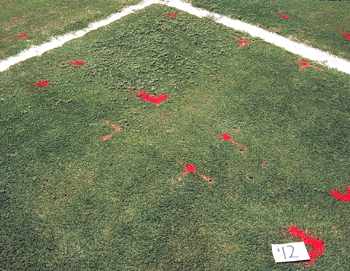 |
|
This was interesting. It's a Basagran treated
plot of |
Three herbicides (Basagran T/O, Illoxan 3EC, and MSMA 6.6) and one PGR (Primo) were not harmful to Ultradwarf greens-type bermudagrasses maintained at 1/8 inch mowing height, when applied in excess of the label rates. Injury was severe in some cases when Ultradwarf were sprayed on two successive weeks with 5X rates of MSMA.
The most injurious product, MSMA, showed slight symptoms of injury only at two weekly applications at the 2X rate and higher. Illoxan was the second most injurious, and Basagran was the third most injurious, affecting only two of the bermudagrasses, and only at the highest rates of application. Even the most injured plots of the most susceptible grasses recovered nearly completely by 20 July 1999, or 13 days after the second application.
Bermudagrass plots that for whatever reason (aerification, poor genetic makeup, etc.) were in thin or weak condition before spraying suffered much worse than healthy plots.
Two bermudagrasses (Tifdwarf and TifEagle) showed large differences in overall performance and herbicide injury, based on the year the were planted. Plots from 1997 were much weaker and more susceptible to herbicide injury than were plots from 1993. This confirms knowledge documented elsewhere that turfgrass performance in short-term evaluations (up to 2 years after planting) is not as meaningful as in longer-term evaluations (5 or more years).
While the generalizations appear reasonable, specific conclusions (e.g., results from applying a particular product at a defined rate to a particular grass) are applicable only to this one experiment at one location, and may not be assumed to apply to golf course greens under actual use.